How to cover the pipes in the bathroom - the easiest and most effective ways of masking
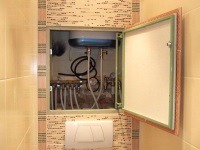
When a renovation is planned in the bathroom, there is a chance to hide unsightly-looking communications, making the interior more attractive. However, if you are going to hide the pipes, it is important to leave the possibility to check and repair them. And there are several ways to solve this problem.
Why hide the pipes
The bathroom is an important part of the house or apartment, which is always sought to give a cozy and beautiful appearance. But even the highest quality and most fashionable repairs will not bring joy if the pipes and other communications are left in plain sight. In addition, unmasked pipes due to high humidity in the room often collect water droplets. The result will be a darkening of the pipes over time.
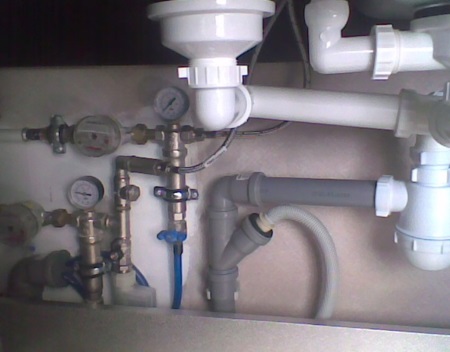
Competent masking of pipes is mandatory in the repair, it will make the room neat, and its design - stylish and modern.
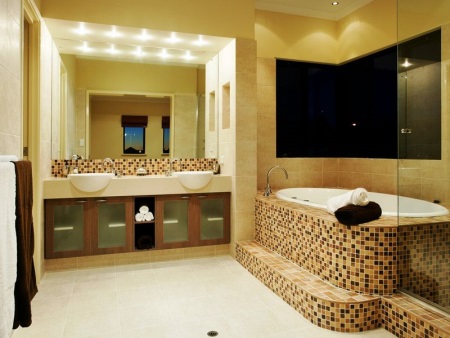
What pipes are installed in the bathroom
Depending on their purpose, pipes in the bathroom can refer to the water system, heating, as well as sewage. The layout of water pipes is more convenient for installation and replacement, but when working with sewer pipes, you should always keep in mind the slope provided in them towards the riser. If there is a heating radiator in the bathroom, then the issues of masking pipes will also affect those that belong to the heating system.
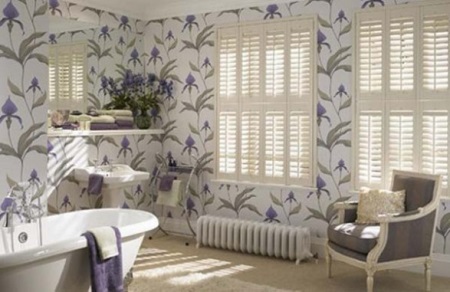
In addition to the purpose of the pipes in the bathroom differ in their material. Nowadays, it is rare to find metal pipes, as modern plastic pipes have a lot of advantages. They are easy to install, no need to paint, easy to replace. Such pipes are lightweight, resistant to corrosion.
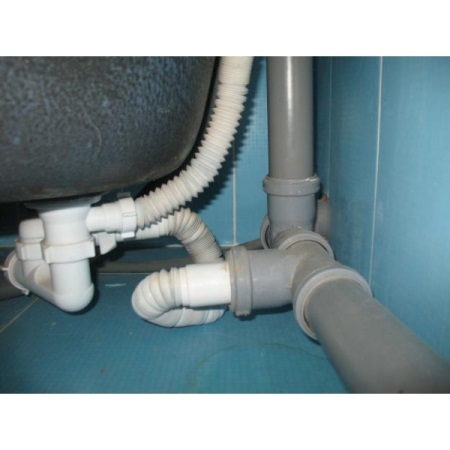
Often for pipes in the bathroom are used quite strong and thick polypropylene pipes. Products made of PVC have less thick walls, although they are attractive in price. However, they cope worse with high temperatures and water pressure. If you choose to install them in the bathroom, be prepared for short life and do not hide them hermetically.
In addition to polymer pipes, it is not uncommon to install metal-plastic and welded steel pipes in bathrooms, but these are more costly options.
What can be hidden, and what can not.
If you are planning a tightly closed masking of pipes, you need to understand that not all communications should hide this way. First of all it will not be suitable for masking fittings - connections in the form of letters X, T or D. They are points where there is an increased risk of leaks. Also do not tightly cover the places where there are meters, filters and other cleaning connections.
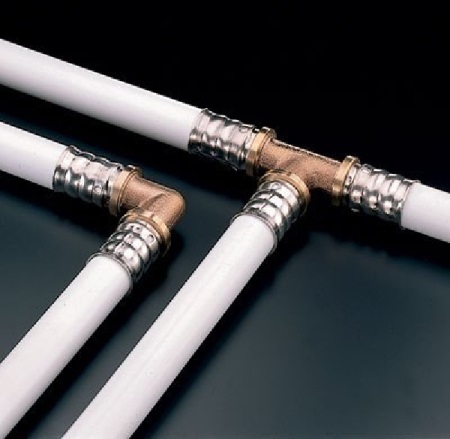
Steel pipes with welded joints and brazed copper pipes can be embedded in the wall. All threaded pipe connections are not recommended to be hidden in the walls unless they can be quickly accessed.
Rules when masking
First, when installing pipes in the bathroom, try to reduce the number of connections. To achieve this will help competent wiring and thoughtful arrangement of equipment.
Secondly, if connections are provided, they should be of the same material from which pipes are made. It is important that their margin of safety is identical or higher.
Thirdly, for quick access to valves, meters, taps and other elements, special hatches should be left.
Fourth, to prevent condensation from forming on the pipes, use insulating materials. In the case of hiding pipes in the wall the presence of insulation will allow the pipes to expand (this is especially important for pipes through which hot water flows).
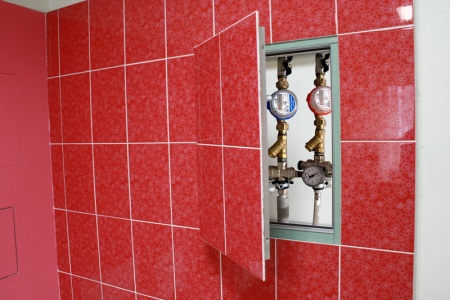
Methods of camouflage
To conceal the communications in the bathroom, different methods are used. Horizontally located pipes with the help of additional work conceal in the walls, performing strobing, and then finishing the surface with tiles or plaster. Also, pipes are often hidden in a box, the construction of which is made of gypsum board or plywood, choosing a material resistant to moisture. Such a box can be finished with tiles or other material.
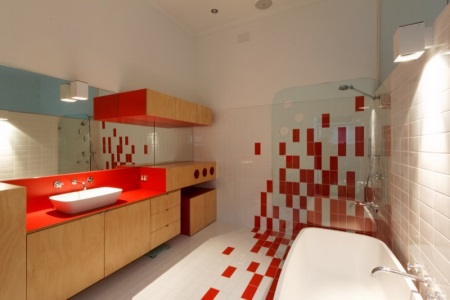
To hide the pipes, you can also create structures that look similar to furniture cabinets. Pipes in such cabinets take up only part of the space, and the remaining area of the shelves is used to store household stuff. Also a popular option is the installation of roller shutters in the bathroom. Choosing a cute decor, they will even decorate the room. And there is always an option for creative people - to paint the pipes, cover with mosaics, apply artificial plants, stucco or other ideas.

Hiding in the wall
It is recommended to hide only pipes made of copper or polypropylene in the walls - firmly welded or soldered, without threaded connections. In this way you can aesthetically conceal pipes running horizontally. They are placed in the corrugation in advance, then after screwing in the wall and treated with a concrete or cement screed on top. On the dried screed, you can lay laminate, tile and other coatings.
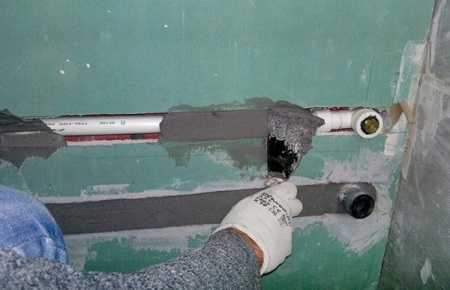
It is important that the screed is completely dry before using the pipes. If you turn on the hot water when the screed is damp, the coating will crack. The method is quite expensive and on forces and time (requires a long preparation). It is often chosen for new apartments (when repairing from scratch), or in the case of redevelopment. For its implementation it is necessary to use a grinder, chisel, hammer and other tools.
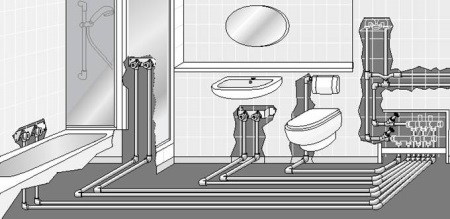
Before you start tapering, it is important on paper to make a scheme of wiring, which will be the most optimal for your bathroom. Making such a scheme, take into account the route and diameter of the pipes, as well as the features of the walls (whether they are suitable for drilling, how thick, whether reinforcement is needed, how thick the screed will be). In the right places (adapters, taps, meters, threads) arrange inspection windows.
Remember that horizontal drilling is not performed in panel walls. Also, such a manipulation is not carried out when the wall width of half a brick.
The box of plasterboard
For this method, a moisture-resistant variant of plasterboard is used. The popularity of this method of masking is provided by its simplicity and manufacturability, as well as financial affordability.
Drywall helps to hide not only the pipes, but also the entire sewer system, but a significant disadvantage is the reduction of usable space, which for small bathrooms is an acute problem.
Most often gypsum board boxes are installed in new buildings, where bathrooms are more spacious than similar rooms in the "panel houses" or "hruschevkas".
The basis of the box is a metal profile or framework of wooden bars. It is covered with plasterboard, which is then finished to your liking.
To access certain parts of the wiring, holes are made in the drywall, on which the access doors are installed.
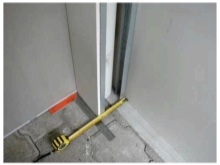
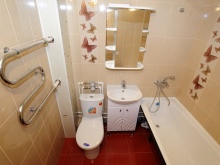
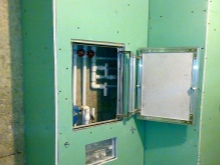
Disguise with furniture and screen
A practical option to hide the pipes in the bathroom is to create a furniture design. With its help, the interior can look richer and more attractive. Usually such a design is a cabinet with shelves.
For vertically located pipes, a variant of a ready-made cabinet-penal, in which the back wall is taken away, and in the shelves cut out a place for the pipes, is suitable. However, it is not easy to find furniture that will be able to come into contact with wet pipes for a long time and not deteriorate. And treating all surfaces of the purchased cabinet with a means to protect against moisture will spend your money and time.
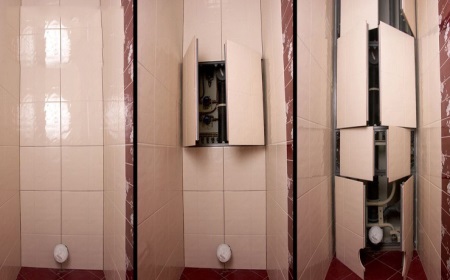
Therefore, more often in the case of masking communications furniture design create their own or to order.
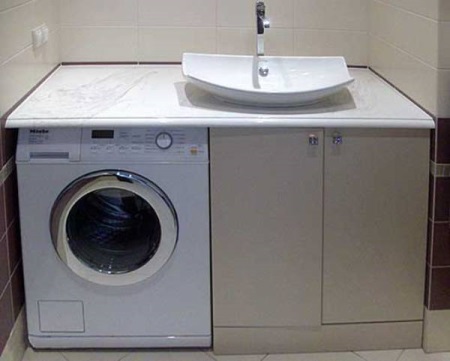
The material for bathroom furniture is often chosen laminated chipboard, resistant to moisture. Doors in such a cabinet are chosen depending on the location of the plumbing - sliding or hinged. After installing the construction, all the gaps are treated with silicone for greater tightness.
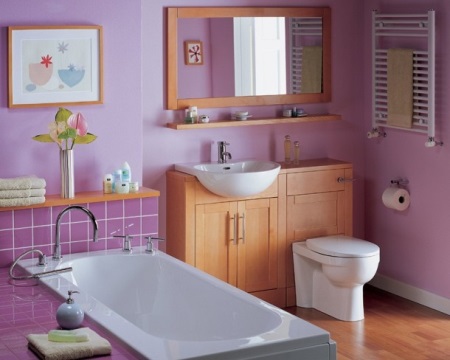
Another way of masking, which can be called easy and practical - the use of a special screen. This is a frame in which plasterboard or plastic panels are fixed on 2 rails. Such a screen is inexpensive and looks nice. It is easy to remove, simplifying the repair, but the disadvantage of it is the same as that of the plasterboard box - reducing the area of the room.
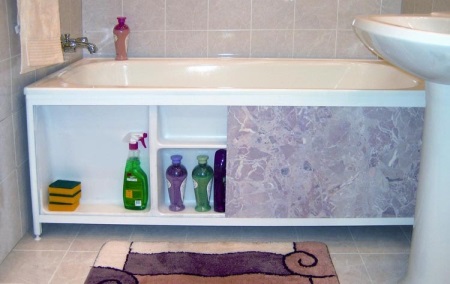
Catwalk for the bathtub
This is an interesting solution to disguise the communications, which does not take up useful space. Since most pipes run closer to the floor, it is enough to make a small step to hide the plumbing. For such a catwalk, particleboard with treatment with moisture-repellent materials is used.
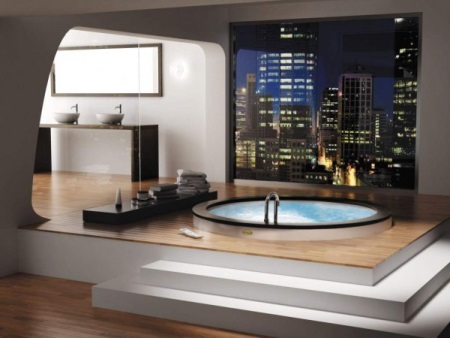
Roller blinds
Their main advantage is the possibility of easy full access to pipes, filters, meters and the rest. Toilet and bathroom shutters come in a variety of materials. They are the best option if the pipes pass in a recess. It is worth installing them during the repair work, then you will avoid unnecessary costs.
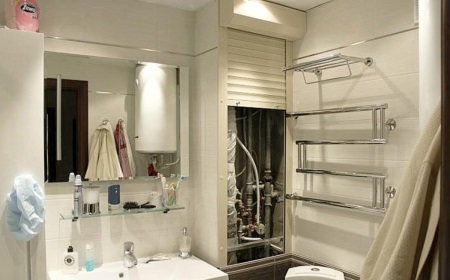
Pros and cons
In the case of masking in the wall, the disadvantage will be possible restrictions for the work, because horizontal strobing in a panel building and work with thin walls is prohibited. Also, if the inappropriate and low-quality pipes are hidden in the wall, there is a risk of a breakthrough and flooding the neighbors. Even if you make observation windows, access to communications will still be limited.
The plus side of the option to hide pipes in the walls is the aesthetics of the bathroom. You can finish off the top of the hidden pipes at will, for example, tiling. In addition, this way you will not reduce the working space.
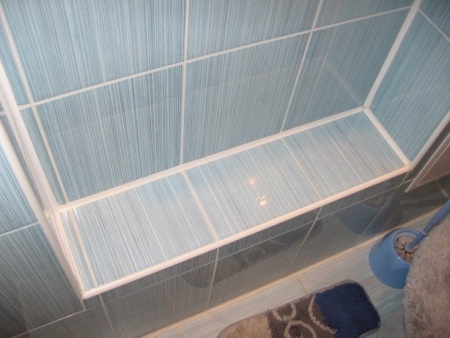
The option with the box of plasterboard also limits access for repair or inspection of communications. To replace pipes, the box would have to be completely dismantled and reinstalled after repairs. In addition, the installation of the box will take away valuable centimeters of space in the bathroom.
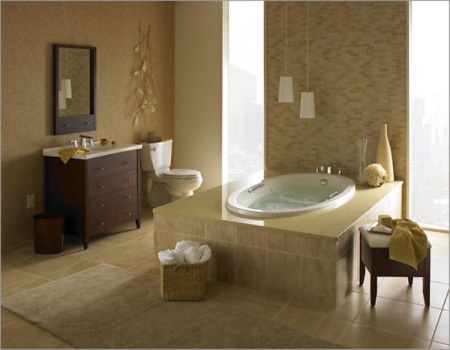
By choosing roller shutters, on the contrary, you will get maximum access. It is a practical and very mobile option. But, since they use rather soft materials for their manufacture, roller shutters are easy to damage (bend or break) if you lean on them or hit them.
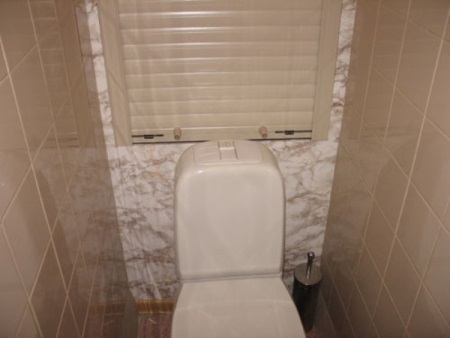
The disadvantage of masking pipes with furniture is contact with moisture. Even water-resistant material deteriorates over time, and to prolong the life of bathroom furniture, it should be wiped dry frequently. Silicone-treated places in such furniture should always be checked (so that the layer of silicone is not broken). Scratches should also be avoided. The advantages of using furniture as a way to hide the pipes is an attractive appearance of the room, as well as practicality, because in the cabinet you can store different accessories.





I like the option with the cabinet-penel, tiled